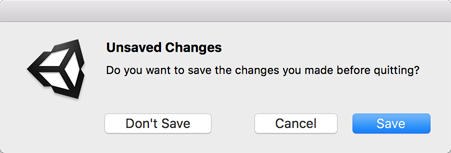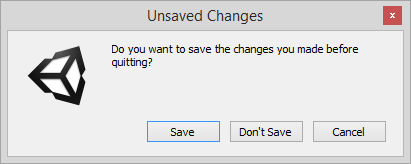参数
| title | 对话框名称。 |
| message | 对话框的用途。 |
| ok | 所选的对话框功能。 |
| cancel | 关闭对话框,不执行任何操作。 |
| alt | 选择备选的对话框用途。 |
返回
int
Returns the ID of a button. IDs are 0, 1, or 2 and they correspond to the ok, cancel and alt buttons respectively. An ID of 1, which corresponds to cancel, returns if the dialog is closed or the user presses the Escape key.
描述
显示含有三个按钮的模态对话框。
用于在编辑器中显示消息框。DisplayDialogComplex 类似于 DisplayDialog。此 DisplayDialogComplex 成员
显示一个含三个按钮的对话框。这些按钮代表 cancel、cancel 和 DisplayDialogComplex。
DisplayDialogComplex 返回对应于 cancel、cancel 和 alt 按钮的整数 0、1 或 2。ok 按钮是默认选项,也可以按 Enter 键激活。cancel 按钮被认为是“cancel”按钮,通常不应执行任何操作。在 PC 上,也可以通过按 Escape 键或单击对话框窗口的关闭按钮来激活该按钮。在 Mac 上,也可以通过按 Escape 键来激活该按钮(前提是该按钮名为“Cancel”)。
除了 ok 和 cancel 按钮之外,alt 按钮还允许您为用户提供另一种选择。此按钮没有固定的键盘快捷键。
For compliance with platform UI guidelines, the actual display order of the buttons is platform-dependent:
On Windows, the display order is: ok, alt, then cancel.
On macOS, the display order is: alt, cancel, then ok.
另请参阅:DisplayDialog。
针对以下示例的 macOS 显示对话框按钮。\
针对以下示例的 PC 显示对话框按钮。
以下脚本引用示例将创建一个复杂的显示对话框。所选按钮
将使系统调用 Unity EditorApplication 静态函数。
using UnityEngine; using UnityEditor;
public class DisplayDlgComplexExample : EditorWindow { // Lets you save or not before quitting, or cancel.
[MenuItem("Example/Quit")] static void Init() { int option = EditorUtility.DisplayDialogComplex("Unsaved Changes", "Do you want to save the changes you made before quitting?", "Save", "Cancel", "Don't Save");
switch (option) { // Save. case 0: EditorApplication.SaveScene(EditorApplication.currentScene); EditorApplication.Exit(0); break;
// Cancel. case 1: break;
// Don't Save. case 2: EditorApplication.Exit(0); break;
default: Debug.LogError("Unrecognized option."); break; } } }